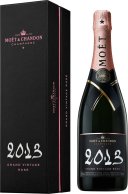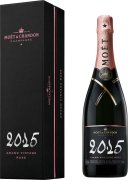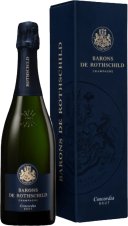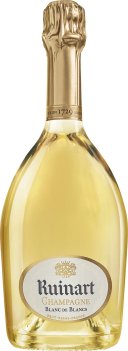Lanson Black Label Champagne
Lanson Black Label continues to stand out in the non vintage Champagne crowd with its quality consistency year after year. Lanson, with its pedigree and history that rivals any Champagne house, is easily one of the best value non vintage Champagne's, with its fine and elegant palate that continues right across the tongue. A soft and pure texture follows showcasing the delicate acid structure of one of the true Champagne bargains.
Gosset Grand Blanc de Blancs Non-Vintage
Product Information: This Champagne highlights the more mineral characters of the different Champagne varying terroirs. Dialling into the chalky minerality, the Chardonnays are selected from various crus - Avize, Chouilly, Cramant, Villers-Marmery, Trépail - where the chalk breaks through to the surface in the Montagne de Reims, Vallée de la Marne and the Côte des Blancs. Earthy mineral aromas, very refined, delicate and attractive overall, with aromas of white flowers, citrus and a trace of honey. Lovely tension! As crisp and lively as it gets. Bottled at the end of the spring following the harvest and with 4 years minimum ageing in the cellars. The dosage is a low 7g/l adjusted with precision to preserve the balance between freshness and fruit without masking the wine’s character and purity. Maker: The oldest Wine House in Champagne: Aÿ 1584 The history of the Gosset family goes back five centuries to Jean Gosset (1484-1556), “Lord of Aÿ and Mareuil”, who was the first official ancestor in the lineage. The origins of “Maison Gosset” itself date back to the year 1584 when Pierre Gosset, Lord and Alderman of Aÿ, decided to set up a négociant business. 16 generations, all of direct lineage, have continued to build upon his work in Aÿ-Champagne and ensured that Champagne Gosset’s savoir-faire, lives on. Towards the end of 1993, the Champagne Gosset became part of the family-owned Renaud-Cointreau group which has since made it its mission to preserve the Gosset style. In the late 20th century, Champagne Gosset’s association with the Cointreau family, as well as the birth of the Gosset Celebris vintage cuvées, propelled the Champagne House to be amongst the most prestigious Champagne Houses. The unique bottle Jean Gosset first used the antique bottle that would become the emblem of the Gosset Champagne House in 1760. This bottle is an exclusive model that used to be part of the family’s collection of ancestral bottles. It owes its name to the “antique glass” colour of the glass paste from which it is produced. This elegant bottle is bears a neck label known as the “necklace medallion” named after Albert Gosset (truly one of a kind in the Champagne region), is instantly recognisable. Philosophy: Gosset is dedicated to crafting wines with perfect balance between freshness and distinctive character. Each cuvée reflects the region’s diverse terroirs, sourced from 140 hectares of Champagne vineyards. Their unique vinification process preserves natural fruit freshness and enhances aromatic expression, resulting in Champagnes with great mineral freshness, deep varietal character, and excellent aging potential. This approach delivers rich, balanced, and complex drinking experiences for connoisseurs and enthusiasts alike. Nose - Chalky, Savoury, Herbaceous Earthy mineral aromas, very refined, delicate white flowers, marjoram and floral honey. Palate - Lemon, Sherry Notes, Energetic Nervy, crisp and lively on the palate. Lemon peel, white peach, subtle nougat and sherry complexity. Young and fresh overall. Finish - Chalk, Sea Spray, Minerality A clean, appetising finish and aftertaste. Lip-smacking.
Gosset Grand Rose Non-Vintage
Product Information: This rosé has a high percentage of Chardonnay, which imbues freshness and precision, complemented by Pinot Noir vinified as both white and red base wines. The red wines are derived from different Champagne crus (Ambonnay, Bouzy, Cumières) and are vinified and blended to obtain a very fine and crunchy fruit. Bottled at the end of the spring following the harvest. This wine spends a minimum of 4 years ageing in the cellars. The dosage is adjusted with precision (8 g/l) to preserve the balance between freshness and fruit without masking the wine’s character and purity. A very tasty aperitif style wine. Moreish. The first impression is white flowers, hawthorn, green apples and citrus. As the Champagne warms up, a hint of grapefruit peel comes to the fore, accompanied by almond, ginger, and star anise. Almond and sherry like notes continue on the palate. Very energetic, interesting and satisfying blush Champagne. Maker: The oldest Wine House in Champagne: Aÿ 1584 The history of the Gosset family goes back five centuries to Jean Gosset (1484-1556), “Lord of Aÿ and Mareuil”, who was the first official ancestor in the lineage. The origins of “Maison Gosset” itself date back to the year 1584 when Pierre Gosset, Lord and Alderman of Aÿ, decided to set up a négociant business. 16 generations, all of direct lineage, have continued to build upon his work in Aÿ-Champagne and ensured that Champagne Gosset’s savoir-faire, lives on. Towards the end of 1993, the Champagne Gosset became part of the family-owned Renaud-Cointreau group which has since made it its mission to preserve the Gosset style. In the late 20th century, Champagne Gosset’s association with the Cointreau family, as well as the birth of the Gosset Celebris vintage cuvées, propelled the Champagne House to be amongst the most prestigious Champagne Houses. The unique bottle Jean Gosset first used the antique bottle that would become the emblem of the Gosset Champagne House in 1760. This bottle is an exclusive model that used to be part of the family’s collection of ancestral bottles. It owes its name to the “antique glass” colour of the glass paste from which it is produced. This elegant bottle is bears a neck label known as the “necklace medallion” named after Albert Gosset (truly one of a kind in the Champagne region), is instantly recognisable. Philosophy: Gosset is dedicated to crafting wines with perfect balance between freshness and distinctive character. Each cuvée reflects the region’s diverse terroirs, sourced from 140 hectares of Champagne vineyards. Their unique vinification process preserves natural fruit freshness and enhances aromatic expression, resulting in Champagnes with great mineral freshness, deep varietal character, and excellent aging potential. This approach delivers rich, balanced, and complex drinking experiences for connoisseurs and enthusiasts alike. Nose - Sherry Complexity, Grapefruit Peel, Ginger Flower The first nose expresses white flowers, hawthorn, green apples and citrus. As the Champagne warms up, a hint of grapefruit peel comes to the fore, accompanied by ginger and star anise. Palate - Pineapple, Intense, Saline On the palate, flavours of citrus fruit mingle with pineapple and finish with a sparkling saline note. Finish - Lingering, Moreish, Savoury Excellent style. Long-lingering aftertaste is clean and dry and moreish. Very energetic, interesting and satisfying.
Ayala Le Blanc de Blanc
Founded by Edmond De Ayala in 1860, the House Ayala possesses a remarkable history, rooted in the visionary spirit that resonates with its melodious name from distant lands. The name Ayala appears almost serendipitous, intricately tailored for the village of Aÿ, where the House has proudly stood since its inception. Edmond De Ayala, an inquisitive and bold personality, consistently pursued the path less travelled. Vibrant with the essence of excellence and a spirit of adventure, the House of Ayala continues to be inspired by the indomitable founder who paved its way. In contrast to the prevailing French tradition of dosage, which exceeded 150 g/L during that era, Edmond De Ayala took a bold and audacious move by unveiling "dry champagne" in 1865, with a mere 21 g/L dosage. As a true pioneer, he possessed a discerning vision to revolutionize the Champagne landscape by introducing a drier style, which has created a profound impact to the modern world. Through bespoke craftsmanship, House Ayala employs a tailored approach, working with a diverse selection of crus to achieve the utmost balance and skilfully express the exceptional terroir surrounding Chardonnay, the house's emblematic grape variety. Champagne Ayala relentlessly pursues the finest raw materials from the Champagne region and currently boasts a palette of 70 crus, with 50 of them dedicated to Chardonnay. These crus are sourced from the most esteemed terroirs of Champagne. This remarkable diversity, a distinctive feature of the house, contributes to the complexity and vibrant aromatic freshness found in their blends. The house maintains 20 hectares of their own vineyards, situated in esteemed locations such as the Montagne de Reims, encompassing Aÿ Grand Cru and Dizy, as well as the Côte des Blancs, including Chouilly and Oger, both classified as Grands Crus. Additionally, they have vineyards in Champvoisy and Passy-Grigny in the Vallée de la Marne. With an unwavering commitment to pure expression of the raw materials, Champagne Ayala is transitioning their vineyards to organic viticulture and has obtained HEV and VDC certifications. The House consistently fosters trusting relationships with winegrowers and supports them in their environmental endeavours. Elaborated in limited quantities, exceptionally during the most expressive years, Le Blanc de Blancs brings to the light all of the elegance and the purity from the Chardonnay of the Côte des Blancs. This terroir is home to the most beautiful Chardonnays with a great ageing potential, including three Grands Crus which form the fundamentals of the blend. Chouilly, the House’s own vineyard, complete and subtle, brings a silky texture, a freshness, and an aromatic diversity to the cuvée. Le Mesnil-sur-Oger brings the tension, the precision, and a beautiful ageing capacity, in perfect harmony with the chalky minerality of Cramant. A signature blend, enriched by a selection of remarkable Premiers Crus. Recognizable by its both pure and creamy style, Le Blanc de Blancs is a genuine ode to Chardonnay. The signature cuvée of Caroline Latrive. Ensuring a consistent style, she does not hide her love of Chardonnay, and gives it a central place in her blends. Brilliant and contemporary, this prestigious cuvée flourishes in a special bottle, promoting the development of the organoleptic profile during the 6 years of ageing on lees in the cellars. The ultimate epicurean aperitif, Le Blanc de Blancs 2016 also marvellously goes with a lemony sea bream ceviche, a prawn risotto, or a braised veal fondant with rosemary.
Taittinger Prestige Rosé Non-Vintage
The Taittinger Prestige Rose is a unique and complex blend. The signature Taittinger high proportion of Chardonnay (30%) brings elegance and delicacy to the blend, while a quantity of still red wine (15%) produced from the best Pinot Noirs from Montagne de Reims and Les Riceys is added to the final blend. It is this still red wine that gives the cuvee its unmistakable colour and vibrant intensity on the palate. The Prestige Rose can be described as lively, fruity, fresh and elegant.
Moët & Chandon Grand Vintage Rosé Champagne
Moët & Chandon is arguably the most famous name in the world of Champagne. The first impression that strikes when tasting the Grand Vintage 1999 is an impression of wealth, both in the development of aromas and flavours of the wine in the mouth.
Pommery Cuvée Louise half
Created in homage to Louise Pommery, daughter of Madame Pommery, Cuvée Louise is a wine of exceptional and absolute purity which expresses the quintessence of the knowhow of the Maison Pommery.Cuvée Louise finds its origin within three grands crus; Avize, Cramant and Aÿ - true gems of the Champagne region.The 2006 vintage, uniquely available in half bottle size, expresses all its lightness and delicacy with subtle minerality. The harmony is perfect. Aromas of white flowers are wonderfully associated with hints of prunes and white peaches, creating a silky and fine effect. It embraces the palate with grace and elegance, the finale is long and tense.
Agrapart & Fils 7 Crus Extra-Brut Non-Vintage
Product Information: The NV Brut 7 Crus is a very pretty. Bright, mineral and intensely vibrant, the 7 Crus is full of energy and refreshment. 7 Crus is a blend of two harvests: in this case, 60% is 2021 from 1er Cru sites; and 40% is 2020 from Grand Cru sites. The reserve wine was raised in neutral, 600-litre oak casks from François Chidaine and Didier Dagueneau. The breakdown is 90% Chardonnay and 10% Pinot Noir. Even at this first level, the wine is aged for three years on lees. It was disgorged with 6 g/L dosage. This is the most immediately seductive cuvée in the Agrapart range, yet it is still extremely fine. It’s long, deep and saline with some gentle grip. Sadly, we do not get nearly enough. The reviews below refer to a previous disgorgement. Disg. March 2024. The Agrapart range begins with a non-vintage wine called 7 Crus. The name refers to the seven Côte des Blancs villages from which the wine derives. These include Avize (from younger vines aged 20 to 40 years), Cramant, Oger, Oiry, Avenay-Val-d’Or, Coligny and Vauciennes. Like all Agrapart wines, the fruit is from 100% estate-owned and farmed vineyards. Maker: In 1894 at the beginning of France’s lively Belle Époque “the beautiful era” or Europe's golden era between 1871 to 1914. Arthur Agrapart started the family domaine that would become Champagne Agrapart & Fils. The estate has weathered many storms, including World War I, an economic depression, and the German Occupation during World War II, which devastated stock by millions of cases throughout the region. In the 1950s, Arthur’s grandson Pierre set out to rebuild the family business by making wines of quality rather than following the commercial trends of the day. Pierre’s sons Pascal and Fabrice took over the reins in 1990, farming their own vineyards along the prestigious Côte de Blancs, as well as blending and bottling their own wines. By the early 2000s, upon realising the brothers did not have the same goals for the future of the estate, Pascal began the long-term process of dividing the estate in two. His vineyards would become the backbone of Domaine Pascal Agrapart, focusing on the unique single vineyard cuvées that he had championed since the early 1990s and the remaining family vineyards would provide the fruit for the assemblage cuvées, 7 Crus & Terroirs, still bottled under the Agrapart & Fils label today. Pascal has been joined by his eldest son Ambroise and their ultimate goal is to produce only wines bearing the Pascal Agrapart label. Philosophy: The winery is based in the grand cru village of Avize, famous for its cuvees of 100% Chardonnay. Pascal and Ambroise farm 10 hectares from some 60 different vineyard plots in the Côte de Blancs, including Oger, Cramant, Oiry and Avize. They farm using only homeopathic vine treatments, composts, manures, and regular plowing. The Agraparts were one of the first families to bring the draft horse back to the vineyards, and named a cuvee in honour of their first four-hooved friend, Vénus. In plowing the old-school way, they expose the clay and limestone soils to immune-boosting properties of the wind and sun. While they once were the object of ridicule, they now lead a return to authentic, ancestral practices. Their quality control extends to manual harvests, a selective triage of the grapes, and the use of native yeasts during fermentation. Malolactic fermentations are employed to round out the intensity of these mineral-driven Champagnes. The wines age on their lees for an extended period of time, and then are racked to both stainless steel and neutral oak barrels—the latter being a rarity in Champagne before Pascal started using them. All wines are bottled unfined and unfiltered. Nose - Apricots, Pears, Fennel Vibrant fruit here, with peaches, apricots, lemons, pears, almonds and spicy anise notes. Palate - Intense Minerality, Pillowy Palate, Citrus Peel medium to full-bodied, ample and pillowy palate. Finish - Chalk, Lingering Citrus, Saline White flowers, chalk and citrus linger.
Champagne Barons De Rothschild Concordia Brut Non-Vintage
A very fine blended wine based on a majority of Chardonnay, the Rothschild Family’s take on the Champagne tradition. Reserve wines are used for up to 40% of the blend, an exceptional sign of quality and regularity over time. Pale golden highlights, combined with very fine bubbles that carry an abundant, persistent foam.
Ruinart Blanc de Blancs Non-Vintage
The House of Ruinart stands in a league of its own, defying convention and captivating with its unique legacy. Founded in 1729, it holds the distinction of being the very first Champagne House, a visionary endeavour inspired by the foresight of a monk who possessed a remarkable intuition far beyond his era. In the heart of the Champagne region, specifically in Reims, a significant moment unfolded on September 1st, 1729. It was then that Nicolas Ruinart, driven by the profound influence of his visionary monk uncle, drafted the historic charter that marked the birth of Maison Ruinart, forever etching its name as the world's pioneer in champagne production. Little did they know that this bold initiative would pave the way for an enduring enterprise that thrives and prospers even after nearly three centuries, leaving an indelible mark on the course of history. During the remarkable period of the mid-18th century, Ruinart made a significant acquisition to enhance its champagne production. The House secured ownership of ancient crayères, subterranean chalk quarries meticulously carved beneath the historic city of Reims. These extraordinary caverns served as the ideal sanctuary for storing their precious bottles, ensuring optimal aging and maturation. Building upon its reputation for innovation, Ruinart continued to push boundaries. In 1764, the House achieved yet another milestone by successfully shipping the first-ever Rosé champagne across the vast expanse of Europe. This ground-breaking achievement introduced a new dimension to the world of champagne, captivating connoisseurs with its captivating hues and captivating flavors. Bestowed with nobility and adopting the esteemed name Ruinart de Brimont in 1817, the family has diligently guided the House for over two centuries. With each passing generation, a new Head of House emerges, bringing forth their unique talents and unwavering commitment to serve the lineage of Ruinart. This steadfast succession ensures the preservation of the family's legacy, as each successor devotes themselves to upholding the traditions and values that define Ruinart. Their collective efforts have propelled the House to unparalleled heights, solidifying its reputation as a bastion of excellence in the world of champagne. Ruinart Blanc de Blancs embodies purity of the Chardonnay grapes from which it is made exclusively. Made primarily with Premiers Crus from the Cote des Blancs, and Montagne de Reims Terroirs, it is intensely aromatic. The blend is 100% Chardonnay from various years (20 to 25% of which are reserve wines from the 2 previous years). The nose is powerfully reminiscent of fresh fruits with dominant notes of citrus and exotic fruits, followed by a touch of jasmine, white peaches and pink peppercorns. A perfect champagne for aperitifs, particularly in spring and summer. It is an excellent complement to seafood and shellfish; perfect with a sea bass or bream tartare. It would also be very good with seared sole. Note - this item does not come with a gift box.

















